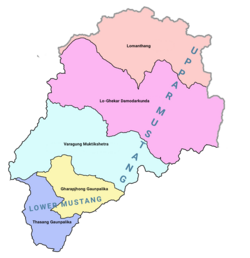| 1380–2008 | |||||||
|
Flag | |||||||
 Upper & lower Mustang with local level bodies | |||||||
| Status | Independent sovereign state (1380-1964) Dependency of Nepal (1964-2008) | ||||||
| Capital | Lo Manthang | ||||||
| Official languages | |||||||
| Religion | |||||||
| Government | Monarchy | ||||||
| Raja/Gyelpo (King) | |||||||
• 1380-1400s (first) | Ame Pal | ||||||
• 1964-2008 (last) | Jigme Dorje Palbar Bista | ||||||
| History | |||||||
• Established | 1380 | ||||||
• Abolished by the Federal government | 7 October 2008 | ||||||
| Area | |||||||
• Total | 2,020[1] km2 (780 sq mi) | ||||||
| Population | |||||||
• Estimate | 7,000[1] | ||||||
• Density | 3.47/km2 (9.0/sq mi) | ||||||
| |||||||
| Today part of | |||||||

Upper Mustang (formerly Kingdom of Lo) is an upper part (Northern area) of Mustang District, which is located in Nepal. The Upper Mustang was a restricted kingdom until 1992 which makes it one of the most preserved regions in the world, with a majority of the population still speaking traditional Tibetic languages. Tibetan culture has been preserved by the relative isolation of the region from the outside world. Life in Mustang revolves around tourism, animal husbandry, and trade.
The Upper Mustang comprises the northern two-thirds of the Mustang District of Gandaki Province, Nepal. It consists of three rural municipalities namely Lo Manthang, Dalome, and Baragung Muktichhetra.
The southern third (lower Mustang) of the district is called Thak and is the homeland of the Thakali community, who speak the Thakali language and whose culture combines Tibetan and Nepalese elements.
Mustang's status as a kingdom ended in 2008 when its suzerain Kingdom of Nepal became a republic. The influence of the outside world, especially China, is growing and contributing to rapid change in the lives of Mustang's people.[2] Development work has increased in recent years.
- ^ a b c Raffaele, Paul (April 1998). "Into the Forbidden Kingdom of Mustang". Reader's Digest. 421. 71.
- ^ Mustang: A Kingdom on the EdgeAl Jazeera Correspondent Archived 2020-06-12 at the Wayback Machine
